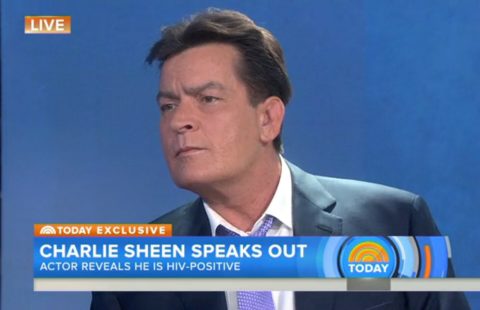Let’s talk about Charlie Sheen and HIV myths

Charlie Sheen’s HIV-status “coming out” left many people battling a range of emotions. Seeing him speak nervously yet openly in regards to his private medical information was at once heartbreaking and awe-inspiring. It took so much courage to answer the prying questions of Matt Lauer with the honesty and dignity that, frankly, many people dissociate with Sheen. It’s hard to come to terms with the sensationalizing of Sheen’s personal life. After all, if all he says is true, what does it matter to us? Why should we care?
Having Sheen as the poster child of HIV is perhaps both blessing and curse for advocacy purposes. His irresponsible and erratic behaviour of the past has become synonymous with his name, and the fact that he slept with prostitutes and many, many others could lead some people to believe that his promiscuous behaviour is to be blamed for his infection with the virus, and thus could become associated with others who are infected. On the other hand, he is a celebrity and has the ability to ignite conversation about the virus and the advancements that have been made in HIV research. Likely, as web posts, articles and tweets circulate, issues will be brought to the forefront. So here, we talk to Christopher Thomas, a spokesperson for ACT, an advocacy organization for those with HIV, about some info about the disease that warrants the spotlight:
Learning that one is HIV-positive is no longer a death sentence, so what are the treatment options?
“Over the past 20 years, advances in HIV treatment have been remarkable in every way. The combinations of antiretrovirals available to folks are personalized, meaning some work best for X but not Y, but there generally are effective treatments available to all people living with HIV. Advances in HIV treatment options mean that HIV-positive people can live long and healthy lives. Moreover, research has shown that these same treatments mean that ‘poz’ folks can lead active, healthy sex lives, without fear of HIV transmission to their HIV-negative partners. Treatment as prevention is a newer method that shows that treating HIV stops the onward transmission of the virus.
What are some common myths?
“Most prominently, many people believe that HIV and AIDS are the same thing, and that if someone is HIV-positive, they have AIDS. HIV is a virus; AIDS is a range of conditions which occur when a person’s immune system is seriously damaged by HIV infection. Secondly, [I think there’s the myth] that HIV is a criminal or moral issue. It’s not. HIV is a public and personal health issue and should be treated as such. Finally, a common myth is that condoms are the only way to prevent HIV. This is rooted in the earlier days of the epidemic when condoms really were the only way to prevent new transmissions. Fortunately, times have changed. Now there are lots of new exciting prevention options, like a new method called treatment as prevention, and it’s about HIV-positive people attaining a suppressed viral load through treatment. When the amount of virus in a poz person’s blood drops below levels that can be seen on current HIV tests, that effectively eliminates the risk of onward transmission of HIV. There’s more on that at hivnow.ca, a campaign we did this summer. Second is PrEP, short for Pre-Exposure Prophylaxis. PrEP is a daily pill taken by HIV-negative people that prevents them from becoming HIV-positive.”
What about the stigma—does Sheen’s announcement help or harm efforts?
“Mr. Sheen’s decision to announce on national television that he is HIV-positive takes a significant degree of courage and we shouldn’t forget that. Charlie Sheen will have access to the best antiretroviral treatments available. Medically speaking, chances are that he will live a full and healthy life. What is of more concern is the apparent level of stigma that he has already faced, and there are serious concerns about his mental health going forward. As demonstrated in the weeks leading up to his decision to disclose, there is a lot, A LOT of stigma surrounding sex and HIV. Given the magnitude of Charlie Sheen’s celebrity, there will be more conversations happening and more exposure to those conversations than before. A wider audience for important and often neglected aspects of our health is a positive thing. In Canada, there are over 70,000 people living with HIV and more than a million in America, yet we often go months and months without seeing anything about HIV in the mainstream media. Getting the word out about the importance of testing, the exciting options for treatment and prevention, and shedding light on the significant stigma around HIV is important.”
Could you share some HIV stats in Canada?
“HIV rates differ depending on where you are in Canada. In Vancouver, gay/bi/queer men, people who use drugs and indigenous people are the majority of new cases being reported, whereas in Toronto most of the new cases are occurring among gay men and women from countries where HIV is endemic. It’s funny, in certain circles there seems to be a taboo, a reluctance, to say that gay men and people who use drugs are the ‘face of HIV/AIDS’ because we want to believe that can’t possibly still be the case. In fact, it’s still true that many of the same groups who were heavily burdened by HIV and died of AIDS-related illnesses in the 1980s and 1990s continue to be affected by HIV and AIDS in 2015. As time wears on, the virus has increasingly been seen to follow existing faults in the power structure of our society.”
On a finishing note, though there have been advancements in treatment, HIV is still very serious and you need to protect yourself by getting tested regularly, using condoms during sex (even oral, though transmission risk is lower for this) and not sharing needles. It seems like a no-brainer, but if ever there were a time to reinforce the age-old message of safe sex, the time is now.
And let’s offer Sheen the respect he deserves, people. Bravo, Charlie. Thanks for getting the convo going.








